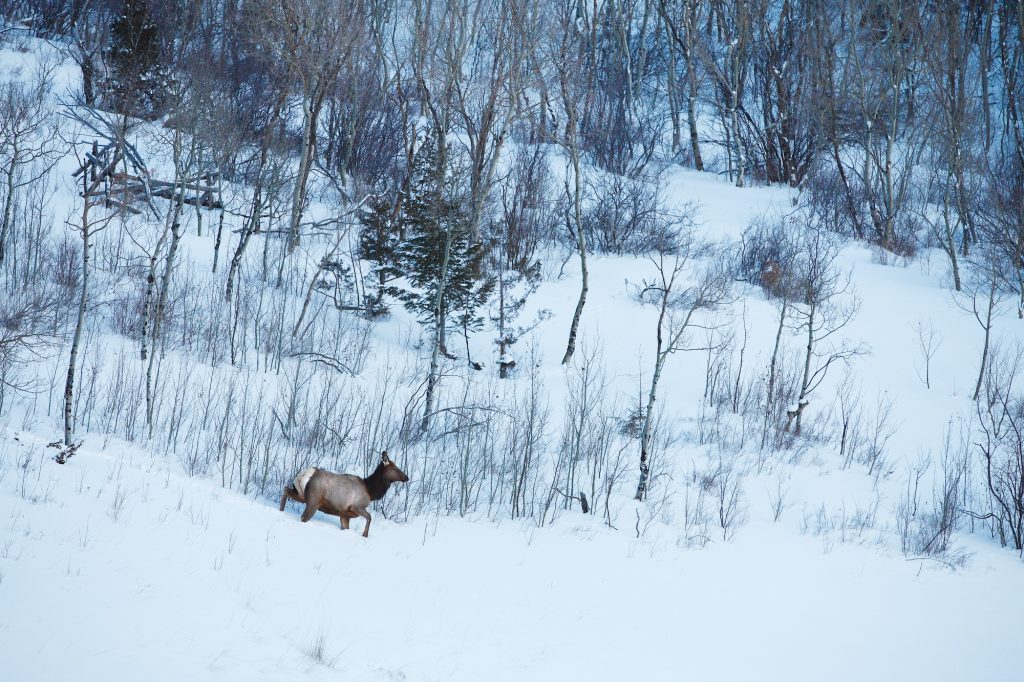
Eagle Valley Wild/Courtesy photo
Sunrise breaks over the Cordillera Ridgeline. Below, in the meadow where they bedded down the evening before, Rocky Mountain elk shake the frost off their coats. They spent much of the spring and summer roaming this alpine landscape, feeding on lush grasses, forbs, and wildflowers. But the seasons are rapidly shifting, and the herd knows that the shorter days and colder nights mean that soon the best foraging will be found lower in the valley.
In the coming weeks, as the last leaves fall from the trees and snow begins to blanket the upper slopes, the elk will make their descent.
Like mule deer and bighorn sheep, elk have an extensive range and move according to seasonal food availability. Their migration patterns date back centuries, although changes in land use, ecosystem composition, and climate have forced elk to adjust their seasonal timing. Fortunately for our local herds, the residents of Eagle County have made wildlife habitat conservation a priority.
The Cordillera Ridgeline has been protected under a conservation easement since 2015, meaning that elk will forever be able to use this valuable landscape. Meanwhile, the nearby Creamery Ranch Open Space, Homestead “L,” and Homestead I and II Open Spaces have also been permanently protected through conservation easements since 2012. Combined, these properties in the Lake Creek Valley provide critical habitat connectivity for many wildlife species, including elk. This connectivity is essential for species’ survival, especially as seasons change and animals seek out foraging opportunities and shelter.
When winter is at its most bitter, elk can take refuge in the Eagle River Preserve, a property in the heart of Edwards that has been protected under a conservation easement since 2005. Together, Eagle River Preserve and the abovementioned parcels total almost 570 acres — a mosaic of land conservation that benefits the wildlife we all love. Our community can feel proud that we’ve forever saved this land, from the high ridgeline down to the valley floor.

Support Local Journalism
But land conservation alone isn’t enough to keep vulnerable wildlife safe during the harsh winter months. Elk and the many other species we coexist with depend on us to be wildlife stewards. We can do this by honoring their centuries-old movement patterns, being particularly vigilant while driving, and encouraging our neighbors to do the same. When recreating, we can respect seasonal trail closures and keep a courteous distance when we encounter wildlife. Animals that are continuously exposed to stressors, including hikers, skiers, and curious dogs, have much greater difficulty surviving the long winter.
What’s an appropriate distance to maintain when viewing wildlife? Follow these steps: Fully extend your arm, make a thumbs-up, and close one eye. If you’re not able to completely cover the animal with your thumb, slowly step backward until you can. These actions will make a huge difference.
As a recent transplant from Phoenix, where my only backyard visitors were scorpions, cottontail rabbits, and the occasional coyote, I’m amazed by the incredible array of charismatic wildlife we have here in Eagle County. It’s a privilege to share a home with such magnificent animals as elk and mule deer — a privilege I don’t take for granted. By making small but crucial adjustments to my behavior, I can help ensure that these species continue to exist here for generations to come.
The sun sets behind the Cordillera Ridgeline. Below, in the Lake Creek Valley, a herd of Rocky Mountain elk uses the last precious moments of daylight to graze before bedding down for the night. The coming winter months will put their hardiness and resilience to the test, but with protected critical habitat and a caring community of wildlife stewards on their side, the herd’s chances look promising.
Keri Inouye is the Community Engagement Manager with Eagle Valley Land Trust. She coordinates EVLT’s community conservation programs, including Future Conservationists and the Community Land Connection Series. To learn more, please visit https://evlt.org/join-us/.
